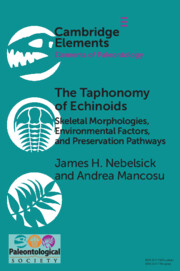Refine search
Actions for selected content:
82 results
The Impact of Secondary Mortuary Practices on Representation and Distribution of Commingled Elements from Umm an-Nar Human Skeletons in Communal Tombs
-
- Journal:
- Advances in Archaeological Practice , First View
- Published online by Cambridge University Press:
- 28 August 2025, pp. 1-18
-
- Article
-
- You have access
- Open access
- HTML
- Export citation
Shell remains as indicators of predatory activity in shallow benthic communities of San Sebastián Bay, Southern South America
-
- Journal:
- Journal of the Marine Biological Association of the United Kingdom / Volume 105 / 2025
- Published online by Cambridge University Press:
- 27 August 2025, e91
-
- Article
- Export citation
The Pliensbachian at the Peniche Global Stratotype Section and Point (GSSP, Portugal) – a section full of remarkably preserved worms
-
- Journal:
- Geological Magazine / Volume 162 / 2025
- Published online by Cambridge University Press:
- 28 July 2025, e23
-
- Article
-
- You have access
- Open access
- HTML
- Export citation
Criteria for inferring seafloor arrival position in teleosauroid carcasses (Crocodylomorpha: Thalattosuchia) and comparison with other marine vertebrates
-
- Journal:
- Geological Magazine / Volume 162 / 2025
- Published online by Cambridge University Press:
- 04 July 2025, e19
-
- Article
-
- You have access
- Open access
- HTML
- Export citation
The ‘king’ of Newgrange? A critical analysis of a Neolithic petrous fragment from the passage tomb chamber
-
- Article
-
- You have access
- Open access
- HTML
- Export citation
Arqueología de paisajes emergentes: Historia ocupacional y formacional de Cerro de los Gatos (Tierra del Fuego, Argentina)
-
- Journal:
- Latin American Antiquity , First View
- Published online by Cambridge University Press:
- 23 January 2025, pp. 1-21
-
- Article
- Export citation
The Use-Life of Ancestors: Neolithic Cranial Retention, Caching and Disposal at Masseria Candelaro, Apulia, Italy
-
- Journal:
- European Journal of Archaeology / Volume 28 / Issue 1 / February 2025
- Published online by Cambridge University Press:
- 13 November 2024, pp. 3-23
-
- Article
-
- You have access
- Open access
- HTML
- Export citation
Aportes del sitio Hangar a los modelos de dieta y distribución del guanaco en las pampas de Argentina
-
- Journal:
- Latin American Antiquity , First View
- Published online by Cambridge University Press:
- 09 May 2024, pp. 1-18
-
- Article
- Export citation
A preliminary bioarchaeological study of the funerary urns from Los Tamarindos, Tierra Caliente, in Michoacan, Mexico
-
- Journal:
- Ancient Mesoamerica / Volume 35 / Issue 2 / Summer 2024
- Published online by Cambridge University Press:
- 07 August 2023, pp. 368-387
- Print publication:
- Summer 2024
-
- Article
-
- You have access
- Open access
- HTML
- Export citation
The distribution of fossil pollen and charcoal in stalagmites
-
- Journal:
- Quaternary Research / Volume 118 / March 2024
- Published online by Cambridge University Press:
- 16 May 2023, pp. 62-74
-
- Article
-
- You have access
- Open access
- HTML
- Export citation
Chapter 2 - Hard Evidence
-
- Book:
- The Unstoppable Human Species
- Published online:
- 16 March 2023
- Print publication:
- 23 March 2023, pp 22-49
-
- Chapter
- Export citation
The unique Late Paleolithic artifactual bone assemblage from the Volchia Griva site, Western Siberia
-
- Journal:
- Quaternary Research / Volume 114 / June 2023
- Published online by Cambridge University Press:
- 06 March 2023, pp. 93-113
-
- Article
- Export citation
Effects of chemical weathering on the exceptional preservation of mineralized insects from the Crato Formation, Cretaceous of Brazil: implications for late diagenesis of fine-grained Lagerstätten deposits
-
- Journal:
- Geological Magazine / Volume 160 / Issue 5 / May 2023
- Published online by Cambridge University Press:
- 01 March 2023, pp. 911-926
-
- Article
- Export citation
Morphological variation in the rangeomorph organism Fractofusus misrai from the Ediacaran of Newfoundland, Canada
-
- Journal:
- Geological Magazine / Volume 160 / Issue 1 / January 2023
- Published online by Cambridge University Press:
- 18 August 2022, pp. 146-166
-
- Article
-
- You have access
- Open access
- HTML
- Export citation
Silicification of feathers in a modern hot spring in New Zealand
-
- Journal:
- Earth and Environmental Science Transactions of The Royal Society of Edinburgh / Volume 113 / Issue 2 / June 2022
- Published online by Cambridge University Press:
- 22 April 2022, pp. 119-125
- Print publication:
- June 2022
-
- Article
- Export citation
The Volchia Griva mineral oasis as unique locus for research of the mammoth fauna and the late Pleistocene environment in Northern Eurasia
-
- Journal:
- Quaternary Research / Volume 109 / September 2022
- Published online by Cambridge University Press:
- 19 April 2022, pp. 157-182
-
- Article
- Export citation
15 - Toward the Nondestructive Imaging of Cementum Annulations Using Synchrotron X-Ray Microtomography
- from Part II - Protocols
-
-
- Book:
- Dental Cementum in Anthropology
- Published online:
- 20 January 2022
- Print publication:
- 10 February 2022, pp 249-257
-
- Chapter
- Export citation
Plants and Subsistence during the Fluted-Point Period of the Northeast
-
- Journal:
- American Antiquity / Volume 87 / Issue 2 / April 2022
- Published online by Cambridge University Press:
- 01 December 2021, pp. 368-376
- Print publication:
- April 2022
-
- Article
- Export citation

The Taphonomy of Echinoids
- Skeletal Morphologies, Environmental Factors, and Preservation Pathways
-
- Published online:
- 21 September 2021
- Print publication:
- 21 October 2021
-
- Element
- Export citation
